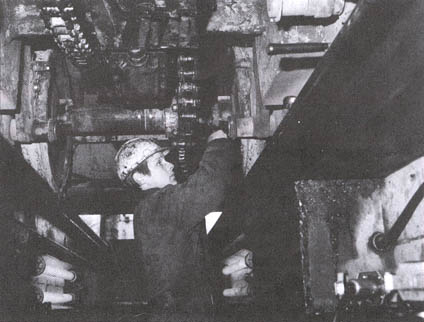Vol. 17 No. 4
April, 1987
|
Stay Safe in 87
|
|
Mucking Around at Rogers Pass
By Tana Hobbs

Preventative Maintenance: Manning Kumagai Joint Venture
mechanic Michael Warkentine installs a drive chain on the underside of a muck train locomotive.
Rogers Pass British Columbia - CP Rail is mucking around on the Rogers
Pass Project - tunnel mucking, that is.
| |

All Aboard: Muck train operators Rod Zimmer ( L ) and Moe
Guy, Selkirk Tunnel Constructors, emerge from the east end of the Mount Macdonald tunnel with a load of muck
for disposal in the Bear Pit.
|
Excavation of the 14.6-km Mount Macdonald tunnel and removal of the debris, called "muck", is
dependent on narrow gauge two-rail systems, one at each end of the tunnel.
The two tunnel contractors use 107-cm gauge railway systems - much like the narrow gauge system featured
in the film "Indiana Jones". The mini-railways are 36 cm narrower than standard gauge and are
used to haul muck out of the tunnel.
"Production schedules hinge on the fact that all mining cars remain in working condition with minimal downtime
so the tunnel muck removal system runs smoothly", said Al Steward, project engineer, Manning Kumagai Joint
Venture. "Preventative maintenance is the key to keeping the fleet in tip-top condition".
| |

Sidekick: It takes more than a kick to get these muck
train cars to dump their load. The debris is from the benching operation taking place nearly two kilometres
inside the east end of Mount Macdonald.
|
At the west end, Manning Kumagai Joint Venture's mini-railway fleet includes nine Plymouth diesel
locomotives ( 23 and 32 tonnes ), thirty-six Moran 10-cubic-metre capacity muck cars, five
Moran Agitator ( concrete container ) cars, three flat cars, one rail mounted backhoe/crane, one car for transporting
workers, and one scissor lift car ( for carrying, lifting, and placing ventilation pipe ).
Of the 36 muck cars, 32 are in constant operation. Tunnel muck is transported to a point just outside the west
portal, transferred to CP Rail air-dump cars, and used for double-tracking and bank
widening projects along the main line.
| |

Down the Hatch: Bob Canaicov, laborer, Manning Kumagai
Joint Venture, watches as concrete fills this 10-cubic-metre Moran Agitator Car. The car is then
taken into the tunnel where the concrete is pumped behind the steel lining form to create the smooth tunnel
walls.
|
A different group of four cars is taken off the rails each week for preventative maintenance. Locomotives are also
rotated on a regular service schedule to reduce downtime.
Oil levels must be checked and parts greased. Engines, exhaust systems, and transmissions must be monitored.
"These locomotives have had high wear levels on transmissions", Mr.Steward said. "The heavy loads are
always transported uphill on the 0.7 percent grade from the tunnel centre to the west entrance. We've had to replace
five transmissions so far. Other than that, the equipment has presented no problems".
The Bear Pit
Selkirk tunnel Constructors, which used a tunnel boring machine for taking out the top 6.8 metres of its portion of
the tunnel, is removing the bottom two-metre bench.
Muck trains transport more than 650-cubic-metres of material each day from the benching operation
outside to a set-off point near the east portal. From here the muck is dumped into a huge fill, called
the Bear Pit, about one kilometre from the site.
Selkirk's fleet is similar to that of its counterparts. It includes thirty, 17-cubic-metre capacity muck
cars, five 10-cubic-metre capacity Moran Agitator cars, four 370-horsepower Plymouth
locomotives, two 200-horsepower locomotives, three flat decks, two elevating vent pipe cars, as well as
cars for explosives, service, and personnel.
"All equipment is under constant watch by both our mechanical staff as well as the machine operators",
said Ron Lyttle, project engineer, Selkirk Tunnel Constructors.
"Every two weeks, mechanics do complete overhauls with periodic changing of wheels, axles, and springs.
Locomotive operators check their unit each shift to ensure proper oil and grease levels".
Differing work schedules mean that Manning Kumagai will demobilize its miniature rail system in the spring of 1988,
while Selkirk Tunnel Constructors' mini-railway will cease operation later that year.
More than 764,000-cubic-metres of rock will be removed using these muck train units.
This CP Rail News article is copyright
1987 by the Canadian Pacific Railway and is reprinted here with their
permission. All photographs, logos, and trademarks are the property of the Canadian Pacific Railway
Company.
|